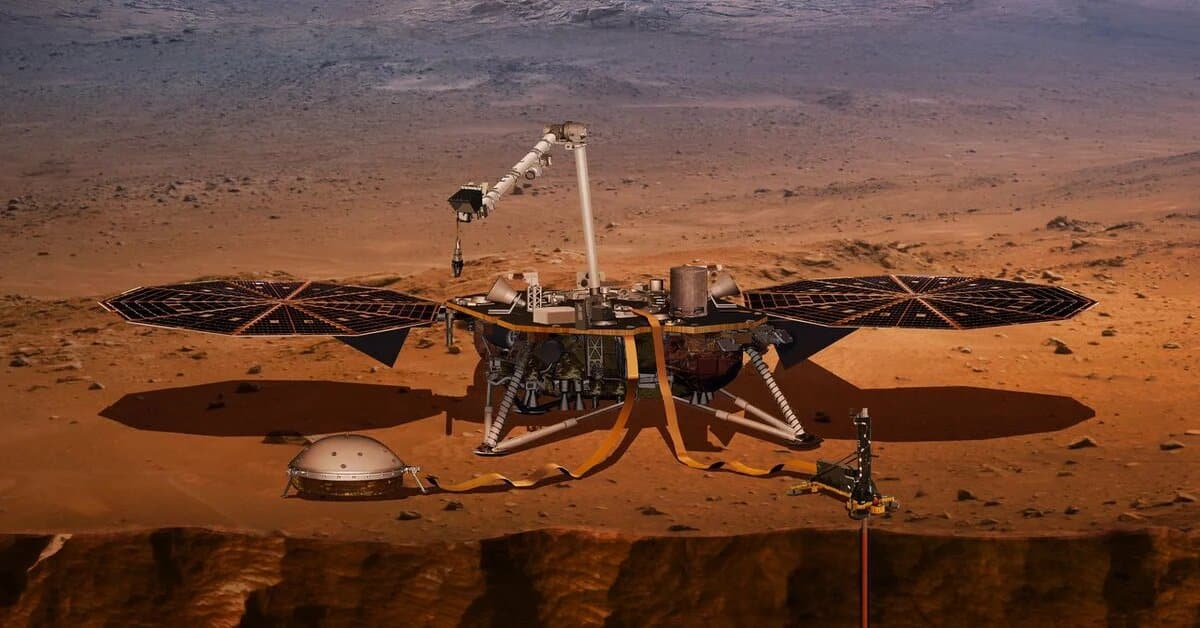With its cold, desert-like surface, Mars is traditionally viewed as one of the most hostile planets to life. However, studies suggest a very different past. About 4 billion years ago, when Earth was just beginning to harbor the first microorganisms, Mars had a more hospitable atmosphere, protective magnetic fields, and rivers flowing across its surface.
The fate of these rivers remains a mystery. Some theories suggest that a large asteroid or even the growth of life forms may have caused a major change in the atmosphere, causing the liquids to evaporate. However, a new hypothesis is gaining traction: the existence of a vast underground ocean on Mars.
Mars: An underground ocean 15 kilometers deep has been discovered
NASA’s InSight probe collected data between 2018 and 2022 that suggests a vast ocean exists beneath the Martian crust. The data suggests that surface water was absorbed by the soil, rather than being converted into gases. “Understanding the water cycles on Mars is crucial to understanding the planet’s evolution and habitability,” says Fabio Rodrigues, an astrobiologist at the University of the South Pacific.
What do we know about the internal structure of Mars?
By analyzing seismic data and meteorite records, InSight has identified a large layer of solidified rock and magma, possibly filled with water. Michael Manga, a researcher at the University of California and co-author of the study published in People“Water is essential for life as we know it,” he said. “While we have yet to find evidence of life on Mars, we have identified a site that could support life.”
After all, is there life on Mars?
Although the surface of Mars is inhospitable, the presence of a wet, mineral-rich layer beneath the crust could provide a habitable environment. Biosignatures, compounds that indicate biological activity, were found by the Perseverance rover in a rock called Chiava Falls, suggesting the presence of microorganisms in the past.
Other discoveries include organic molecules and compounds such as phosphate and iron, which on Earth are associated with the fossilization of microbes. Furthermore, the presence of chemical elements necessary for life (carbon, hydrogen, oxygen, nitrogen, phosphorus and sulfur) has also been detected in the Martian soil.
What will be the next steps?
Despite the promising results, confirming these theories will be a major challenge. Drilling a 15-kilometer tunnel to reach groundwater would be impractical even on Earth. And collecting samples of these specific molecules is currently not possible.
Yet anticipation and curiosity continue to fuel space research. Who knows, one day we may discover that we are not alone in the universe. Mars offers us a glimpse into the possibilities that are still waiting to be revealed.
Key discoveries of the InSight probe
- The presence of an underground ocean 15 kilometers deep
- Earthquake and meteorite data analysis
- The presence of a layer of volcanic rocks containing water
Biosignatures on Mars
The Perseverance rover found biosignatures, compounds that indicate the presence of life, in a rock called Chiava Falls. This discovery strengthens the hypothesis of possible life forms on Mars, although there is no final confirmation yet.
As we continue to explore space, these discoveries remind us of how little we know about our planetary neighbors and the possibilities of finding life beyond Earth.
NASA InSight probe It was launched on May 5, 2018 and landed on Mars on November 26 of the same year.The probe operated for four years until it ran out of power in December 2022. During that time, InSight collected data that helped reveal secrets of the planet's interior, including:
- The first seismic waves to travel through the heart of Mars
- Vibrations from four space rock impacts that fell on Mars in 2020 and 2021
- More than 1,300 “Marsquakes” (Martian tremors)
- Signs of water suggest Mars once had oceans
- A new and improved view of the heart of Mars, although earthquakes occur in a “shadow zone” where seismic waves tend to refract away from InSight
InSight also helped scientists observe that Mars is rotating faster.

“Coffee trailblazer. Social media ninja. Unapologetic web guru. Friendly music fan. Alcohol fanatic.”

